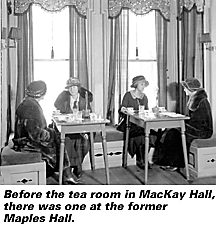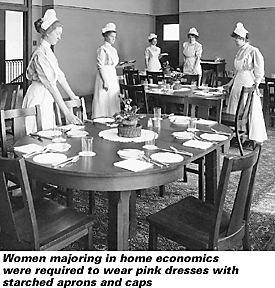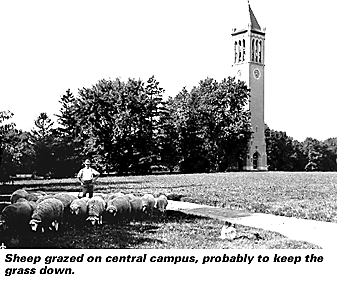Inside Iowa State
December 10, 1999
Flashbacks on the 20th century at ISU
by Linda Charles
When Iowa State opened
more than a century ago,
the entire college fit in one building. Now the main campus covers
about 1,800 acres. As the 21st century beckons, here's a quick look at the
first 100-plus years.
Built in 1900, the president's house was named "The Knole" (after an English estate) by Lovie Storms, wife of college president Albert B. Storms. Later president Raymond Pearson, thinking the name was misspelled, changed it to "The Knoll."
 The Maples, once located north
of Lake LaVerne, was home to the Maples tea room, which became a faculty
club in 1924. The Institutional Management tea room has been operating since
the late 1920s.
The Maples, once located north
of Lake LaVerne, was home to the Maples tea room, which became a faculty
club in 1924. The Institutional Management tea room has been operating since
the late 1920s.
At the turn of the century, nearly all faculty lived on campus. Their children, "The Campus Kids," numbered about a dozen. Imitating the college cheers, they would yell, "Campus Kids, who are we? Kids of the campus -- ISC."
Chapel was compulsory when the university opened and was held daily until World War I.
The Hub opened in 1892 as a campus terminal for the "Dinkey," a railroad that ran between campus and Ames. After the electronic trolley came to campus, the Hub was moved in 1908 a short distance to its current location and turned into a postal substation and bookstore. Automated food snacks appeared at The Hub in 1958.
Five Iowa State presidents are buried in the university cemetery -- Adonijah Welch, Seaman Knapp, William Beardshear, Raymond Pearson and Charles Friley. Iowa State is one of the few universities in the nation to have a college cemetery.
Early Iowa State students had to make their own mattresses, sewing the outside from ticking the university issued them and stuffing them with straw. They had bowls and pitchers in their rooms for bathing and were issued candles for light.
When Spanish influenza hit the nation around 1918, State Gym served as a temporary hospital for soldiers. Hundreds of students were stricken and the campus was quarantined to prevent the spread of the influenza.
The M-Shop in the Memorial Union was so named because the space originally housed a real maintenance shop.
 For a time in the early 1900s, women in the home economics labs were
required to wear pink chambray dresses with starched white aprons and
caps.
For a time in the early 1900s, women in the home economics labs were
required to wear pink chambray dresses with starched white aprons and
caps.
In 1921, Iowa State's electrical engineering department put a 100-watt radio station called 91 on the air. In 1922, the station was licensed under the call letters WOI. WOI-FM started in 1949, and the next year WOI-TV went on the air as Iowa's first television station and the first in the nation to be owned by an educational institution.
For more than 50 years, Iowa State home economics students received actual experience in homemaking through "practice houses." Infant orphans were assigned to homes from 1924 to 1958.
Seed Corn Gospel Trains, the brainchild of Iowa State's Perry Holdren, began traveling the state in 1904 to spread the word to farmers about the improved selection of seed corn.
The Cardinal Guild was founded in 1904 by students who wanted more freedom and a voice in campus affairs. In 1962, the name was changed to the Government of the Student Body.
The Iowa Agriculture College Studentbegan in 1890. In 1897, it became the Iowa State College Student,and in 1947, the Iowa State Daily.
In the early days at Iowa State, literary societies with classical-sounding names, such as The Cliolian Society, were common. Their purpose: to improve "writing, speaking and parliamentary procedures, as well as urbane deportment."
In 1963, a "computer mixer" dance was held at the Memorial Union, with a computer matching up couples.
 Cy made his first appearance on campus during Homecoming 1954. He was named
during a contest in which 17 contestants suggested the name.
Cy made his first appearance on campus during Homecoming 1954. He was named
during a contest in which 17 contestants suggested the name.
In 1895, the ISU football team soundly defeated Northwestern 36-0. A Chicago newspaper said Iowa State "struck like a cyclone," and the name stuck.
In 1880, board at Iowa State cost about $2.25 per week. Room rent was $1.50, $1.25 or 75 cents, depending on the location. By the late 1940s, rent in Pammel Court was $20 per month and by 1975 it had risen to $45. Those who chose to live in University Village in 1975 paid $108 per month.
The first students at Iowa State rose at 5:30 a.m., attended class and studied in the morning, and in the afternoon did grounds and kitchen duty, receiving 3 to 12 cents per hour. (Mandatory labor was dropped in 1884.) Students were confined to their rooms at 7 p.m. and "lights out" was at 10 p.m.
Iowa State initially was open March through November because self-supporting
students needed to find work teaching during the winter and because the
school's heating system wasn't up to Iowa's cold months. In 1900, classes
began in September for the first time.
In 1891, President William Beardshear banned all secret societies after a series of riots between fraternity members and members of independent groups, nicknamed the "barbs." The ban was lifted in 1903 when Albert Storms became president.
At the beginning of the century, there always was a big cheese on tap in the university's creamery for anyone who wanted a sample.
Old Main (on the Beardshear Hall site) originally housed the entire university. There were classrooms on the first floor, women's housing on the second, upperclassmen on the third floor and freshmen on the fourth. Not allowed to mingle beyond the first floor, the students operated a "love line" -- a message on a string lowered to a woman's window.
Before the "Dinkey" railroad, students rode the stagecoach into town. Driver "10-cent Billy" charged 10 cents for everything, from a ride to delivering a letter.
Loud talking, whistling, scuffling in the halls and staircases and boisterous conduct were forbidden in the early days on campus. So too were cards, games of chance, tobacco, intoxicants and, after 1882, dancing.


Sources: Green Hills, an album of Iowa State Memories, ISU
Alumni Association, 1975; and letters archived by ISU special
collections.
Inside Iowa State, inside@iastate.edu, University
Relations Revised
12/8/99
Iowa State homepage
Copyright © 1999, Iowa State University, all rights reserved
URL: http://www.inside.iastate.edu/1999/1210/flashback.html